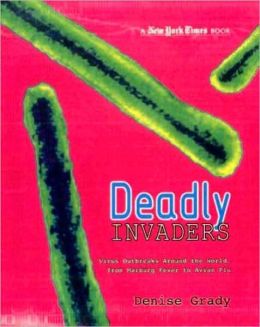by T. Gail Pritchard, PhD, College of Medicine, University of Arizona

http://columnfivemedia.com/work-items/good-infographic-outbreak-%E2%80%94-deadliest-pandemics-in-history/
This past summer, I took a course in global health. Not surprisingly, a great deal of the course focused in infectious diseases in developing nations. As part of our readings, lectures, and discussions, the origins of many of these diseases, the pathways to treatment and/or cure, and the impact on world history was featured. Of course as we covered various infectious diseases from cholera to HIV/AIDS, from malaria to polio, and from small pox to yellow fever, I made connections with children’s and young adult books I have read, and I decided this would be my theme for the September blog. But before I get to the books, let’s consider the differences between pandemics, epidemics, and outbreaks.
Outbreaks may be preludes to epidemics or pandemics. They occur when a disease is “in excess of what would normally be expected in a defined community, geographical area or season” (http://www.who.int/topics/disease_outbreaks/en/). The cause may be from a previously unknown agent, one not previously present in that particular community, or one that has not been present for a long time. For example, just this month 21 cases of measles have been reported by attendees of a particular church in Texas. A visitor who had traveled overseas, contracted the illness, and brought it back to this largely unvaccinated church community.
Epidemics are specific to a city, region, or country and spread rapidly in the affected area (http://www.webmd.com/cold-and-flu/what-are-epidemics-pandemics-outbreaks. One example of a recent epidemic is the cholera outbreak in Haiti.
Pandemics[1] are worldwide outbreaks, affecting many more people than epidemics. The World Health Organization (WHO) classifies an outbreak as a pandemic by its location, how it spreads from one area to the next, and whether it is a new virus, a new subtype, or the recurrence of a virus not in circulation for a very long time. Currently, the World Health Organization has a pandemic alert for AVIAN Influenza A(H5N1). An alert is issued when “a new subtype has been identified in humans.”
Books about Pandemics, Epidemics, and Outbreaks in General
 Outbreak: Plagues that Changed History by Bryn Barnard (2005). Crown Books for Young Readers; ISBN: 10-0375829865, 48 pp.
Outbreak: Plagues that Changed History by Bryn Barnard (2005). Crown Books for Young Readers; ISBN: 10-0375829865, 48 pp.
When I first received this book in 2005, I was intrigued by the cover and immediately sat down to read it. Because of this wonderful photo essay, I began developing a text set about diseases. Barnard’s book provides an excellent synopsis of the process of pandemics, epidemics, and outbreaks; descriptions of famous plagues around the world, and social implications for the affected and the rest of the world (i.e. poverty and access to care). The book contains a glossary and a list of additional sources.
 Pandemic Survival by Ann Love and Jane Drake; illustrated by Bill Slavin (2013). Tundra Books; ISBN: 10-1770492682, 128 pp.
Pandemic Survival by Ann Love and Jane Drake; illustrated by Bill Slavin (2013). Tundra Books; ISBN: 10-1770492682, 128 pp.
Love and Drake provide a highly readable and engaging non-fiction text describing how pandemics and epidemics have affected the world. Through time periods, they give an overview of epidemiology, famous pandemics, vaccines, and those who made remarkable breakthroughs in disease prevention, control, and cure. In addition, they discuss what kinds of pandemics we might face in the future.
 New York Times Deadly Invaders: Virus Outbreaks around the World, from Marburg Fever to Avian Flu by Denise Grady (2006). Kingfisher; ISBN: 10-0753459957, 128 pp.
New York Times Deadly Invaders: Virus Outbreaks around the World, from Marburg Fever to Avian Flu by Denise Grady (2006). Kingfisher; ISBN: 10-0753459957, 128 pp.
This SLJ Starred Review by Denise Grady will hold readers’ attention as she begins with the telling of her trip to Angola to cover an outbreak of Marburg Fever for the New York Times. In her first-hand account, she “relays the challenges of fighting a viral epidemic in a city that lacks such basic services as running water” and the challenges of “language barriers and cultural differences” the medical community faced. From there, she discusses seven different diseases, including the route of SARS, originating with one individual then spreading around the globe. A unique feature of this text is the adjunct aides providing additional information about specific diseases, scientists, and those affected.
Related Resources
TED ED: How Pandemics Spread by Mark Honigsbaum, 7:59. Animated video tracing how a pandemic can spread through a single person. Discuses impact on history, society, economy, and science.
The National Institute of Allergy and Infectious Diseases. How Influenza Pandemics Occur, 3:23. Animated explanation of the development and spread of new viruses.
Soderbergh, S. (2011). Contagion. Rated PG-13.
Wise, R. (1971). The Andromeda Strain. Rated G.
Masters, C. (August 7, 2007). Study: Quarantines Work Against Pandemics. Time.
Brilliant, L. (May 2, 2009). The Age of Pandemics. The Wall Street Journal.
Office of the Surgeon General. (2009). PSA on the H1N1 Outbreak. 1:04.
[1] This is a perfect opportunity for some word study, too. Students can learn about morphemic analysis and parts of speech; i.e. “pandemic can be an adjective (pandemic disease) or it can be a noun (the Spanish Flu Pandemic of 1918-1919)” (http://patients.about.com/od/yourdiagnosis/a/pandemic.htm).
Journey through Worlds of Words during our open reading hours: Monday-Friday, 9 a.m. to 5 p.m. and Saturday, 9 a.m. to 1 p.m. To view our complete offerings of WOW Currents, please visit archival stream.
- Themes: T. Gail Pritchard
- Descriptors: Books & Resources, WOW Currents
